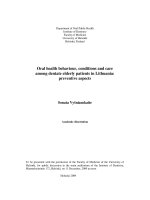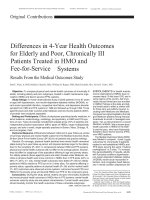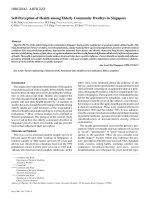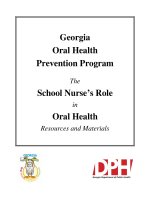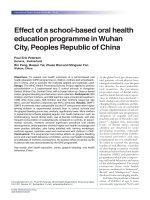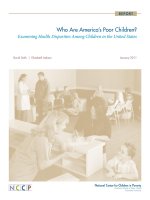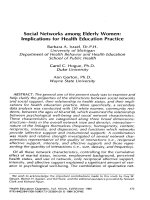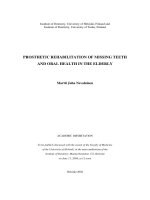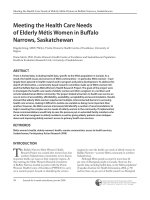Oral Health Status among Elderly Hill Tribe Villagers in Mae Sot, Thailand pot
Bạn đang xem bản rút gọn của tài liệu. Xem và tải ngay bản đầy đủ của tài liệu tại đây (66.07 KB, 5 trang )
Asia Journal of Public Health, July-December 2010 Vol.1 No. 2
Asia Journal of Public Health
Journal homepage:
Original Articles
Oral Health Status among Elderly Hill Tribe Villagers
in Mae Sot, Thailand
Sroisiri Thaweboon* Boonyanit Thaweboon* Futoshi Nakazawa**
Surachai Dechkunakorn* Theeralaksna Suddhasthira* Mari Fujita**
*Faculty of Dentistry, Mahidol University, 6 Yothi Road, Rajthevee, Bangkok 10400 Thailand.
**
School of dentistry, Health Science University of Hokkaido, 1757 Kanazawa, Tobetsu-cho, Ishikari-gun,
Hokkaido 061-0293 Japan.
11
ARTICLE INFO
Article history :
Received July 2010
Received in revised form October 2010
Accepted November 2010
Available online January 2011
Keywords:
Oral health
elderly
hill tribe
Corresponding Author:
Thaweboon S,
Faculty of Dentistry,
Mahidol University,
6 Yothi Road,
Bangkok 10400,Thailand.
Email :
Asia J Public Health 2010;1(2):11-15
ABSTRACT
Objective: This study aimed to determine the oral health conditions among
elderly hill tribe villagers living in Mae Sot, Thailand. Materials and methods:
The study was performed in 5 relatively isolated hill tribe villages. A total of 90
elderly villagers aged 54-80 years participated in this study. Dental caries were
measured by the Decayed, Missing and Filled Tooth (DMFT) index according to
criteria recommended by the WHO. Periodontal status was assessed using the
Community Periodontal Index (CPI). Data were analyzed using ANOVA and Chi-
square test. Results: The prevalence of dental caries was 78% with a mean
DMFT-score of 6.53 +
6.32. All hill tribe villagers had periodontal disease with
the mean CPI-score of 2.06 +
0.32. No statistically significant differences in
DMFT- and CPI-scores were found among the villages or between males and
females. Almost all of them (99%) had never accessed dental health care services.
Very few (11%) had toothbrushes. The habit of chewing betel quid (Areca
catechu L.) was found among all individuals. This may cause the deterioration of
oral hygiene and the development of periodontal disease found in the study
participants. Most of the participants had traditional knowledge of medicinal
plants and they preferred using them as first aid remedies to treat illness.
Conclusion: The oral health status of the elderly hill tribe villagers in Mae Sot,
Thailand was quite poor. Periodontal disease was a major oral health problem
though they did not request any dental care. The results from this study could be
used as base-line information for health authorities and dental professionals for
planning strategies for oral health promotion, prevention, and treatment among the
elderly in hill tribe villages.
INTRODUCTION
Mae Sot is a district in Tak province,
northwestern Thailand. It is located at the Thai-
Myanmar border with the Moei River as a natural
boundary. Therefore, Mae Sot is one of the most
important gateways to Myanmar. Many
indigenous people are native to Mae Sot, and
many hill tribes have migrated from southern
China and Tibet to this area. It is estimated that
there may be thousands of hill tribe people
including Karen, Akha, Lahu (Museur), Lisu, and
Yao
1
.
They have their own languages, cultures,
ways of dressing and beliefs. Hill tribe people
grow rice, corn and other agricultural products on
mountainsides, living in rural remote areas, and
have limited access to health services.
The oral health status of elderly people has
been gaining more importance in both developing
and developed areas because this population
segment is growing rapidly due to extended life
expectancy. Dental caries and periodontal disease
are the two major diseases found in the oral
cavity. According to Reichart and Gehring
2
, the
prevalence of dental caries in >50-year old hill
tribe people of northern Thailand was quite low
with a mean DMFT (Decayed, Missing and Filled
Tooth) score of 0.2. No information regarding
Asia Journal of Public Health, July-December 2010 Vol.1 No. 2
12
periodontal health was reported in this group at
that time.
At present, contact and trade between hill
tribes and local natives has become frequent.
Modernization has increased, causing many
changes to the lifestyle of these people as well as
affecting their health. Thus, the aim of this study
was to determine oral health status in this group of
hill tribe people residing in Mae Sot.
MATERIALS AND METHODS
The study was performed in February, 2008 in
five relatively isolated hill tribe villages in Mae
Sot after approval by the village committees and
in accordance with Helsinki Declaration. They
were Poo Tor, Rom Glao Sahamitr, Pa Dae, Koon
Huay Mae Sot, and Huay Pla Lod villages. After
giving their verbal consent, a total of 90 villagers
aged 54-80 years agreed to participate in this
study. We used 50 years of age and older as our
definition of elderly, which is different from the
general criterion of 60 years and older. The reason
for this is based on the traditional social roles and
functional abilities related to work and health
status of this studied population.
The dental examination took place in the
village where they lived and was performed by
one dentist from the Faculty of Dentistry, Mahidol
University, Thailand. The study participants were
comfortably placed on a chair in front of the
examiner, both sitting. Examinations were
performed with the aid of dental mirrors and ball
point periodontal probes (Martin, Solinger,
Germany) under natural light. The dental caries
experience was measured by the DMFT index
according to criteria recommended by the WHO,
1997
3
.
Periodontal status was assessed using the
Community Periodontal Index (CPI). The ten
index teeth examined consisted of four upper
molars, four lower molars, one upper incisor and
one lower incisor (17, 16, 11, 26, 27, 37, 36, 31,
46 and 47). Each sextant containing at least two
functional teeth was assigned a code number. The
condition of the worst affected site in the sextant
was recorded. Plaque and calculus was evaluated
on all four surfaces of central incisors, canines and
first molars. If one of these teeth was absent, the
tooth distal to that was examined. Plaque and
calculus were identified by means of a probe,
sweeping the buccal, lingual (palatal), mesial and
distal tooth surfaces. Bleeding on probing was
recorded as present or absent after probing at each
probing site on the same teeth that were scored for
plaque and calculus. Pocket depth was measured
from the free gingival margin to the base of the
sulcus. The subjects were classified according to
the highest code number (codes 0-4) assigned to
any sextant of their mouth
4
.
The data were analyzed using analysis of
variance and Chi-square test to evaluate the
statistical significance between variables.
RESULTS
The study population comprised elderly people
from five villages, 28 from Rom Glao Sahamitr
Village, 18 from Poo Tor Village, 23 from Pa Dae
Village, 11 from Koon Huay Mae Sot Village, and
10 from Huay Pla Lod Village. Demographic data
of subjects are shown in Table 1.
Table1 Demographic characteristics of elderly
hill tribe people.
Villages Tribes
Gender Age
male female
51-
60
61-
70
>
70
1. Poo
Tor
(n=18)
Karen 14 4 10 8 0
2. Rom
Glao
Sahamitr
(n=28)
Lahu,
Lisu,
Yao,
Akha
17 11 13 13 2
3. Pa
Dae
(n=23)
Karen 8 15 1 16 6
4. Koon
Huay
Mae Sot
(n=11)
Karen 6 5 8 2 1
5. Huay
Pla Lod
(n=10)
Lahu 3 7 6 3 1
There were more males (53%) than females
(47%). Almost all of these hill tribe people had
never accessed dental health care services. Only
one male reported that he had his tooth filled at a
local hospital almost 20 kilometers down from the
village. Very few (11%) had toothbrushes and
among those who had a toothbrush, only 27%
brushed their teeth twice a day. Interestingly,
almost all of them (94%) disclosed that they
chewed betel quid every day after meals. Seven
(8%) were edentulous. The prevalence of dental
caries in all the elderly hill tribe villagers was
78% with a mean DMFT-score of 6.53 +
6.32.
Median and mean DMFT-scores in each village
were shown in Table 2. No significant differences
in DMFT-score were found between males and
females. Even though those in Pa Dae Village
showed the highest mean DMFT-score, no
significant differences in DMFT-score were found
among the villages.
Asia Journal of Public Health, July-December 2010 Vol.1 No. 2
13
Table 2 Distribution of elderly hill tribe people by dental caries experience.
Villages
Decayed teeth Missing teeth Filled teeth DMFT*
Edentulous
median
mean+
SD
median
mean+SD
median
mean+SD
median
mean+SD
1. Poo Tor 2.2
0.77+
1.98
3
2.72+3.49
0
0
3
3.50+3.95
0
2. Rom Glao Sahamitr 5
2.32+
2.65
5
3.96+5.61
0.5
0.04+0.20
2
6.65+6.32
2
3. Pa Dae 0
0
14
11.85+10.30
0
0
14
11.85+10.30
3
4. Koon Huay Mae Sot 0
0
5
4.70+
6.07
0
0
5
4.70+6.07
1
5. Huay Pla Lod 3
1.33+2.23
2.5
2.33+3.57
0
0
2.5
3.66+5.59
1
* DMFT = Decayed, Missing and Filled Teeth
Table 3 Distribution of elderly hill tribe people by periodontal health.
Villages
CPI Healthy Bleeding
on probe
No. (%)
Calculus
No. (%)
4-5 mm
No. (%)
>6 mm
No. (%)
median mean+SD
1. Poo Tor 2.15 2.14+0.23 0 18 (100) 18 (100) 9 (50) 3 (17)
2. Rom Glao Sahamitr 2.00 1.93+0.32 0 26 (100) 26 (100) 7 (27) 0 (0)
3. Pa Dae 2.20 2.11+
0.07 0 20 (100) 20 (100) 4 (20) 1 (5)
4. Koon Huay Mae Sot 2.35 2.17+
0.22 0 10 (100) 10 (100) 4 (40) 0 (0)
5. Huay Pla Lod 2.00 2.05+
0.14 0 9 (100) 9 (100) 3 (33) 0 (0)
The assessment of periodontal status (Table 3)
according to CPI demonstrated that all hill tribe
villagers had periodontal disease with the mean
CPI-score of 2.06 +
0.32 and had calculus
indicating poor oral hygiene. Almost all of them
had moderate gingival inflammation according to
the classification of Loe, 1967
5
. No statistically
significant differences in CPI-score were found
among the villages or between males and females.
DISCUSSION
No comprehensive data were available for
caries and periodontal status among elderly hill
tribe villagers in Mae Sot District, Thailand. The
data collected showed poor oral health conditions
among the hill tribes. All self-care oral health
habits were excessively poor with high
percentages of not having toothbrush (89%) and
inadequate oral hygiene-related habits such as
regular toothbrushing. Most of them performed
oral hygiene procedures by sanding or polishing
teeth with betel nut shell, charcoal powder, salt,
and miswak or chewing stick.
The mean number of caries expressed as the
DMFT-score was found to be 6.53 of which the
missing component was 5.5. Our results were
different from those of the previous Turkish or
Western Australian studies which reported higher
DMFT-scores of 29.3 and 9.8 respectively. The
major factors to explain these situations were the
characteristics of the people and lifestyle. These
hill tribe villagers lived on mountainsides isolated
from urban areas with a high fluoride level in the
water. In addition, their diet consisted of food
grown on small plots of land and taken from the
surrounding forest. Their diet included highly
abrasive food while excluding those consisting
mostly of refined carbohydrates, and included
such foods as rice, chili paste with fermented soy
bean, salt and vegetables. Consumption of meat
was infrequent. The previous study of Reichart
and Gehring in 1984
2
showed that the mean
DMFT-score of northern elderly hill tribe
villagers in Chiang Mai Province of Thailand was
0.2. We hypothesize that the increase in DMFT-
score among these hill tribes from that reported in
1984 may be the effect of modern lifestyle
invading their way of life such as advertising
media that influenced them to access commercial
cariogenic foods and beverages.
In this study, two results were found to be
similar to other studies
6-8
. First, the same
percentages of males and females were
edentulous. Second, all of these edentulous elderly
and those with missing teeth reported tooth
mobility due to loss of tooth support, the sign of
periodontal disease. Other studies
9-10
have
confirmed that periodontitis is the major cause of
tooth loss commonly found in elderly population
groups in many countries.
Nevertheless, tooth loss was not found
to be as widely prevalent as in other studies. The
percentage of edentulism in this group of hill tribe
villagers (8%) was much lower than the previous
reported rates of 67.4% and 16-30% among the
Turkish
7
and German subjects
11
, respectively.
Asia Journal of Public Health, July-December 2010 Vol.1 No. 2
14
Conversely, it was quite closer to that reported for
the elderly people in Southern Australia (3%). The
reason may be the severity of periodontal disease
in this group was quite low. Less than half of
them (40%) had tooth pockets and very few
(4.8%) had a pocket depth >6 mm.
Even though periodontal disease was a
significant health problem facing these hill tribe
villagers, oral health was generally perceived to
be of lower importance than physical health.
According to a study among the elderly in Italy,
though the level of self-reported problems such as
pain and tooth mobility was high, only a small
proportion of people requested dental care
12
.
The habit of chewing betel quid (Areca
catechu L.) was found in all individuals. Chewing
betel quid is a traditional ritual which dates back
thousand of years from South Asia to the Pacific.
It constitutes an important and popular cultural
activity in many Asian and Oceanic countries,
including Thailand. Many studies have proven
that regular chewing of betel quid is a risk factor
for gum disease and oral cancer
13
. Betel quid
generally consists of areca nut, piper betel leaf,
and slaked lime. An experimental study showed
that areca nut extracts impaired human gingival
fibroblast functions by depleting intracellular
thiols and inhibiting mitochondrial activity,
supporting the concept that betel quid chewing
may affect periodontal health status
14
.
Additionally, areca nut extracts favor the
colonization of periodontopathogens and interfere
with the microbial mechanisms of neutrophils,
suggesting that areca nut extracts might increase
periodontal infection
15-16
. Hence, the chewing of
betel quid may play an important role in the
deterioration of oral hygiene and the increasing
prevalence of periodontal diseases found among
the participants in this study.
Due to their minority status, hill tribes are not
fully recognized in governmental resource
allocation for public health services. Treatment of
dental caries and periodontal disease is expensive
and has been inaccessible to these hill tribe elderly
villagers in Mae Sot. The long distance from
health services forces them to stay in the village
and seek traditional herbal remedies. Most hill
tribe villagers have traditional knowledge of
medicinal plants and they prefer using them as
first aid remedies to treat illnesses such as cough,
toothache or bleeding gums. Among those
reported herbal medicines are Ya Kho (Nicotiana
tabacum L.,) and Ba Ko (Illicium Hook .f.) used
by cooking with chicken to treat a sore tooth or by
chewing daily as preventive medicine
17
.
In conclusion, the data show caries and
periodontal diseases experienced in 90 elderly hill
tribe villagers in Mae Sot, Thailand. Generally,
the oral health was quite poor. Periodontal disease
was a major oral health problem though they did
not request any dental care. The data could be
used as base-line information for health
authorities and dental professionals for planning
strategies for oral health promotion, prevention,
and treatment in this group of villagers.
ACKNOWLEDGEMENTS
The Faculty of Dentistry, Mahidol University
was thanked for funding this study. We gratefully
acknowledge the help of the Royal Patrol Police
Bureau at Mae Sot, the hill tribe leaders and all of
the study participants in Poo Tor, Rom Glao
Sahamitr, Pa Dae, Koon Huay Mae Sot, and Huay
Pla Lod Villages.
CONFLICT OF INTEREST
We declare that we have no conflict of interest.
REFERENCES
1. Ministry of Social Development and Human
Security. Highland communities within 20
Provinces of Thailand. Bangkok: Ministry of
Social Development and Human Security,
2002.
2. Reichart P, Gehring F. Streptococcus mutans
and caries prevalence in Lisu and Karen of
Northern Thailand. J Dent Res
1984; 63: 56-8.
3. World Health Organization. Oral Health Sur-
veys: Basic Methods, 4
th
ed. Geneva: World
Health Organization, 1997.
4. Karikoski A, Ilanne-Parikka P, Murtomaa H.
Oral health promotion among adults with dia-
betes in Finland. Community Dent Oral Epi-
demiol 2003; 31: 447-53.
5. Loe H. The gingival index, the plaque and the
retention index. J Periodontol
1967; 38: 610-6.
6. Saub R, Evans RW. Dental needs of elderly
hostel residents in inner Melbourne. Aust
Dent J 2001; 46:198-202.
7. Unluer S, Gokalp S, Dogan BG. Oral health
status of the elderly in a residential home in
Turkey. Gerodontology 2007; 24: 2-9.
8. Kruger E, Smith K, Atkinson D, Tennant M.
The oral health status and treatment needs of
indigenous adults in the Kimberly region of
Western Australia. Aust J Rehab Health 2008;
16: 283-9.
9. Quteish Taani DS. Periodontal reasons for
both extraction in an adult population in Jor-
dan. J Oral rehabil 2003; 30: 110-2.
10. Meyer MS, Joshipura K, Giovannucci E, Mi-
chaud DS. A review of the relationship bet-
ween tooth loss, periodontal diseases, and
cancer. Cancer Causes Control 2008; 19: 895-
907.
11. Muck F, Mojon P, Budtz - Jorgensen E, Ko-
Asia Journal of Public Health, July-December 2010 Vol.1 No. 2
15
cher T, Splieth C, Schwahn C, et al. Caries
and periodontal diseases of the elderly in Po-
merania, Germany; results of the study of
health in Pomerania. Gerodontology 2004;
21: 27-36.
12. Pizzo G, Guiglia R, Gallo P, D’ Angelo M,
Giuliana G. Request of dental care and perio-
Dontal treatment needs in a population sam-
ple of Palermo. Minerva Stomatol 2002; 51:
35-9.
13. International Agency for Reserch on Cancer.
IARC Monographs on the evaluation of carci-
nogenic risk to humans. Betel-quid and areca-
nut chewing and some areca-nut derived ni-
trosamines, 2004.
14. Chang YC, Hu CC, Lii GK, Tai KW, Yang
SH, Chou MY. Cytotoxicity and arecoline
mechanisms in human gingival fibroblasts in
vitro. Clin Oral Invest 2001; 5: 51-6.
15. Hung SL, Chen YL, Wan HC, Liu TY, Chen
YT, Ling LJ. Effects of areca nut extracts on
the functions of human neutrophils in vitro. J
Periodontal Res 2000; 35: 186-93.
16. Ling LJ, Hung SL, Tseng SC, Chen YT, Chi
LY, Wu KM, et al. Association between betel
Quid chewing, periodontal status and perio-
Dontal pathogens. Oral Microbiol Immunol
2001; 16: 364-9.
17. Inta A, Shengji P, Balslev H, Wangpakapatta-
nawong P, Trisonthi C. A comparative study
on medicinal plants used in Akha’s traditional
medicine in China and Thailand, cultural co-
herence or ecological divergence? J Ethno-
pharmacol 2008; 116: 508-17.
